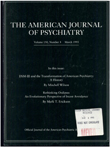Object representations in the early memories of sexually abused borderline patients
Abstract
OBJECTIVE: This study analyzed psychological representations in 58 subjects in order to achieve a better understanding of the relation between adult borderline personality disorder and reported histories of childhood sexual and physical abuse. METHOD: The subjects were 29 inpatients with borderline personality disorder diagnosed according to the Diagnostic Interview for Borderlines, 14 nonborderline inpatients with major depressive disorder according to the Research Diagnostic Criteria, and 15 normal comparison subjects recruited from the community and screened for the absence of psychopathology. Earliest memories were used as the source of mental representations in all subjects. The memories were reliably coded for malevolent affect tone, presence of deliberate injury, and effectiveness of helpers. Family histories of childhood sexual and physical abuse were obtained with the Familial Experiences Interview, a structured interview. Abuse histories for a subset of the subjects were corroborated by interviews with family members. RESULTS: A reported history of sexual abuse, but not a reported history of physical abuse, predicted the presence of extremely malevolent representations in these earliest memories as well as representations involving deliberate injury. These two kinds of representations also discriminated borderline patients who reported histories of sexual abuse from borderline patients who did not report sexual abuse. Mean affect tone (from malevolent to benevolent) did not, however, discriminate sexually abused or physically abused subjects. CONCLUSION: The results suggest that malevolent representations associated with the borderline diagnosis in previous research may be partially related to a history of childhood sexual abuse. Implications for the object relations theory of borderline personality disorder are noted.
Access content
To read the fulltext, please use one of the options below to sign in or purchase access.- Personal login
- Institutional Login
- Sign in via OpenAthens
- Register for access
-
Please login/register if you wish to pair your device and check access availability.
Not a subscriber?
PsychiatryOnline subscription options offer access to the DSM-5 library, books, journals, CME, and patient resources. This all-in-one virtual library provides psychiatrists and mental health professionals with key resources for diagnosis, treatment, research, and professional development.
Need more help? PsychiatryOnline Customer Service may be reached by emailing [email protected] or by calling 800-368-5777 (in the U.S.) or 703-907-7322 (outside the U.S.).



